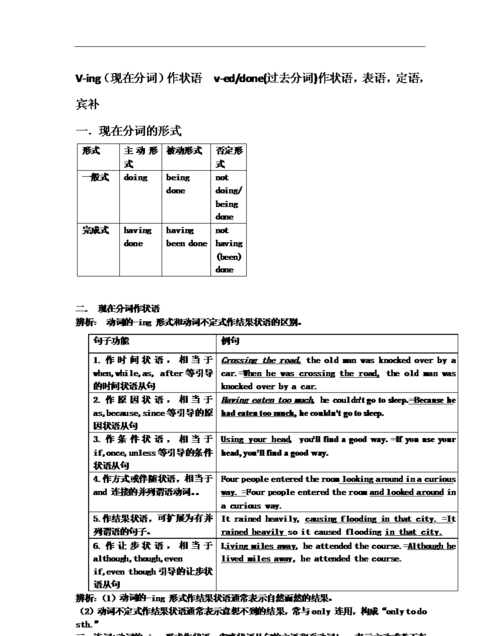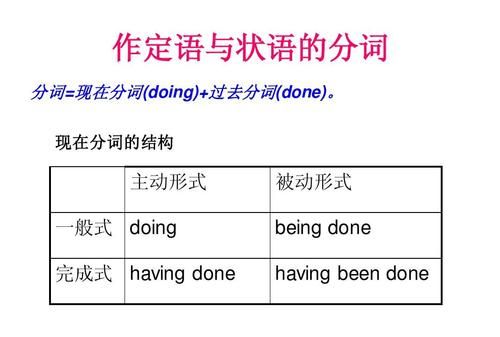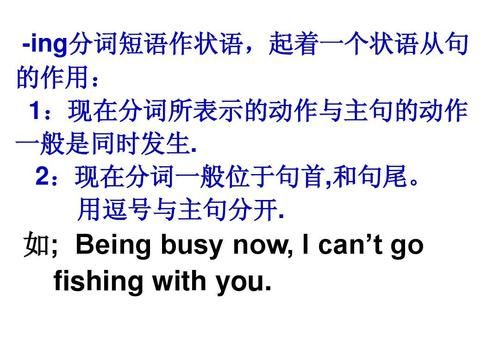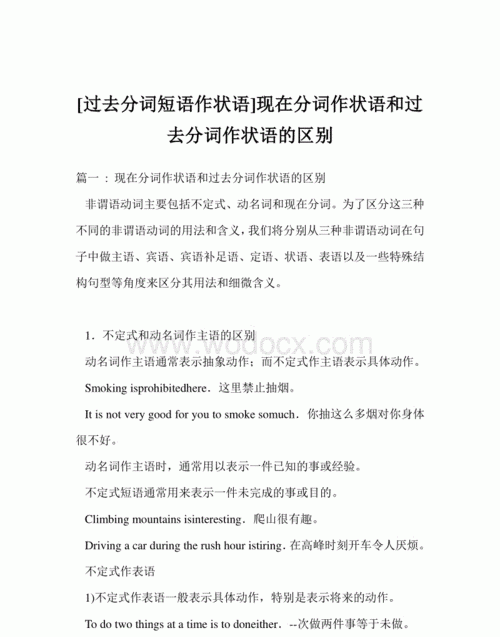本文目录
分词的用法
分词分:现在分词doing形式,过去分词done形式.它们的作用各不相同.
现在分词在句子中担任:
Collecing infromation is very inportant to businessme(主语)
The little girl is afraid of going out(宾语)
Your duty will be keeping watch on that house(表语)
Drinking water should be boiled(定语)
Being ill, the student is absent today(状语)
I felt my heart beating wildly(宾补)
注意:在视觉感官动词后的宾补,如果是现在分词,表示那动作正在进行着,I saw him washing his face我看见他正在洗脸.
如果是后跟动词原形,表示那整个动作都了解.I saw the man walk into the hall.我看见那男子走过大厅
过去分词的作用:
She had a worried look on her face (定语)
The work finished ,they had ten day's leave(状语)
He looked worried after reading the letter(表语)
Some of us though the game lost(宾补).

00个实意动词的 三单形式 过去式 现代分词表
动词ing分词指的是现在分词。
动词ed分词指的是过去分词。
现在分词和过去分词主要差别在于:现在分词表示“主动和进行”,过去分词表示“被动和完成”(不及物动词的过去分词不表示被动,只表示完成)。分词可以有自己的状语、宾语或逻辑主语等。
1)分词作状语分词在句子中作状语,可以表示时间、条件、原因、结果、让步、伴随等。分词做状语时,它的逻辑主语与句子的主语一致。作状语的分词相当于一个状语从句。
2)“while
(
when,
once,
until,
if
,
though等连词)+分词”结构现在分词或过去分词作状语时,有时可以在分词前加while,when,
once,
although,
until,
if等连词。
3)分词作定语分词作定语时,单个的分词通常放在被修饰的名词之前,分词短语一般置于所修饰的中心词后面。现在分词修饰的是发出该动作的名词(即与名词有主谓关系),过去分词修饰承受该动作的名词(即与名词是动宾关系)。
4)分词作宾语补足语现在分词在see,
watch,
hear,
observe,
notice,
feel,
find,
glimpse,
glance等感官动词和look
at,
listen
to等短语动词以及have,
keep,
get,
catch,
leave,
set,
start,
send等使役动词后面与名词或代词构成复合宾语,作宾语补语的成分。
5)分词作表语分词作表语通常看作形容词来用。现在分词表示主语的性质,而且主语多为物;过去分词表示主语的感受或状态,主语多为人。

初中英语差的很怎样才能补起来
(一)、及物动词与不及物动词
英语中按动词后可否直接跟宾语,可把动词分成及物动词与和及物动词。
1.及物动词: 字典里词后标有vt. 的就是及物动词。及物动词后必须跟有动作的对象(即宾语),可直接跟宾语。see 看见 (vt.) +宾语 I can see a boy.
2.不及物动词:字典里词后标有vi. 的就是不及物动词。不及物动词后不能直接跟有动作的对象(即宾语)。若要跟宾语,必须先在其后添加上某个介词,如to,of ,at后方可跟上宾语。
具体每个动词后究竟加什么介词就得背动词短语了,如listen to,look at…..
3. 宾语(动作的对象):是名词或代词,或相当于名词的词或短语(如动名词)。其它词不看作动作的对象呢。
4.举例:“看”
(1)see 看见 (vt.) +宾语 I can see a boy.
(2)look 看 (vi.) x宾语(即不能直接加宾语). Look! She is singing.
Look carefully! (注意:carefully 是副词,不是名词,故不作宾语哟)
(3)look at 看…….+宾语 Look at me carefully! (me是代词,作宾语了)
(二)、什么是反意疑问句
前面是肯定,后面就否定
前面是否定,后面就肯定
eg:
1.It is a find day,isn't it?
2.It isn't a find day,is it?
前面是肯定,后面就否定
前面是否定,后面就肯定
eg:
1.It is a find day,isn't it?
2.It isn't a find day,is it?
(三)初中英语八种时态归纳复习
l 时态是英语学习中一个至关重要的内容,广大初中学生在实际运用时,往往对时态总是倍感棘手,下面我们就归纳复习一下这几种时态。
一、 一般现在时:
l 概念:经常、反复发生的动作或行为及现在的某种状况。
l 时间状语:
always, usually, often, sometimes, every week (day, year, month…), once a week, on Sundays,
l 基本结构:①be动词;②行为动词
l 否定形式:①am/is/are+not;②此时态的谓语动词若为行为动词,则在其前加don't,如主语为第三人称单数,则用doesn't,同时还原行为动词。
l 一般疑问句:①把be动词放于句首;②用助动词do提问,如主语为第三人称单数,则用does,同时,还原行为动词。
二、 一般过去时:
l 概念:过去某个时间里发生的动作或状态;过去习惯性、经常性的动作、行为。
l 时间状语:ago, yesterday, the day before yesterday, last week(year, night, month…), in 1989, just now, at the age of 5, one day, long long ago, once upon a time, etc.
l 基本结构:①be动词;②行为动词
l 否定形式:①was/were+not;②在行为动词前加didn't,同时还原行为动词。
l 一般疑问句:①was或were放于句首;②用助动词do的过去式did 提问,同时还原行为动词。
三、 现在进行时:
l 概念:表示现阶段或说话时正在进行的动作及行为。
l 时间状语:now, at this time, these days, etc.
l 基本结构:am/is/are+doing
l 否定形式:am/is/are+not+doing.
l 一般疑问句:把be动词放于句首。
四、 过去进行时:
l 概念:表示过去某段时间或某一时刻正在发生或进行的行为或动作。
l 时间状语:at this time yesterday, at that time或以when引导的谓语动词是一般过去时的时间状语等。
l 基本结构:was/were+doing
l 否定形式:was/were + not + doing.
l 一般疑问句:把was或were放于句首。
五、 现在完成时:
l 概念:过去发生或已经完成的动作对现在造成的影响或结果,或从过去已经开始,持续到现在的动作或状态。
l 时间状语:recently, lately, since…for…,in the past few years, etc.
l 基本结构:have/has + done
l 否定形式:have/has + not +d one.
l 一般疑问句:have或has。
六、 过去完成时:
l 概念:以过去某个时间为标准,在此以前发生的动作或行为,或在过去某动作之前完成的行为,即“过去的过去”。
l 时间状语:before, by the end of last year(term, month…),etc.
l 基本结构:had + done.
l 否定形式:had + not + done.
l 一般疑问句:had放于句首。
七、 一般将来时:
l 概念:表示将要发生的动作或存在的状态及打算、计划或准备做某事。
l 时间状语:tomorrow, next day(week, month, year…),soon, in a few minutes, by…,the day after tomorrow, etc.
l 基本结构:①am/is/are/going to + do;②will/shall + do.
l 否定形式:①was/were + not; ②在行为动词前加didn't,同时还原行为动词。
l 一般疑问句:①be放于句首;②will/shall提到句首。
八、 过去将来时:
l 概念:立足于过去某一时刻,从过去看将来,常用于宾语从句中。
l 时间状语:the next day(morning, year…),the following month(week…),etc.
l 基本结构:①was/were/going to + do;②would/should + do.
l 否定形式:①was/were/not + going to + do;②would/should + not + do.
l 一般疑问句:①was或were放于句首;②would/should 提到句首。
l Ⅱ. 几种常见时态的相互转换
l 英语中的几种时态在一定情况下可以互相转换,以下是几种常见的转换形式:
一、 一般过去时与现在完成时的转换
n 在现在完成时中,延续性动词能与表示一段时间的状语连用,瞬间动词却不能。但是,可用别的表达方式:①瞬间动词用于“一段时间 + ago”的一般过去时的句型中;②瞬间动词可改成与之相对应的延续性动词及短语,与一段时间连用;③瞬间动词用于“It is + 一段时间 + since + 一般过去时”的句型中,表示“自从……以来有……时间”的意思,主句一般用it is来代替It has been;④瞬间动词用于“Some time has passed since + 一般过去时”的句型中。请看:
A. He joined the League two years ago.
B. He has been in the League for two years.
C. It is two years since he joined the League.
D. Two years has passed since he joined the League.
二、 一般现在时与现在进行时的转换
n 在一般现在时中,at加上名词表示“处于某种状态”,如at work(在工作), at school(上学、上课)等。此短语可与进行时态转换。请看:
l Peter is at work, but Mike is at play.
l Peter is working, but Mike is playing.
三、 现在进行时与一般将来时的转换
n 在现在进行时态中go, come, leave, start, arrive等动词常与表示将来的时间状语连用表示将要发生的动作。如:I am coming, Mum! 意为“我就来,妈妈!”请看:
l The train is leaving soon.
l The train will leave soon.
l 四、“be going to+动词原形”与“will(shall)+动词原形”结构的转换
n “be going to+动词原形”、表示打算、计划要做的事;将来时“will(shall)+动词原形”结构在书面语中,当主语为第一人称时,常用助动词shall。在口语中,所有人称都可以用will。请看:
l We are going to visit the Great Wall next Sunday.
l We shall visit the Great Wall next Sunday.
l Ⅲ. 中考动词时态考点分析
一、 根据时间状语确定时态的原则
l 1. Hurry up! The play for ten minutes. (2002辽宁)
l A. has begun B. had begun C. has been on D. began
l [析] 1. C。since后接时间的起点,for后接时间段,主句动词用现在完成时,应注意瞬间动词与延续性动词的使用。
二、 在复合句根据时态呼应确定时态的原则
l 2. Do you know if back next week? If he back, please let me know. (2002黑龙江 )
l A. he comes; will come B. will he come; comes
l C. he will come; comes D. will he come; will come
n [析] 2. C。if既可引导宾语从句,也可引导状语从句。充当宾语从句的连接词时,相当于whether,词义是“是否”。充当状语从句的连接词时,词义是“如果”。从时态看,if引导宾语从句时谓语动词的时态应根据主句的时态作相应的变化;引导表示将来动作或状态的条件句时,若主句用一般将来时,则从句通常用一般现在时表示将来。
三、 根据上下文已有时态信息点确定时态的原则
l 3. –When this kind of computer ?
l --Last year. (2002天津)
l A. did; use B. was; used C. is; used D. are; used
l [析] 3. B。此例由下句的时间状语推断出一般过去时态,并且要考虑到被动语态。
四、 利用上下文语意确定时态的原则
l 4. –Hi! Lin Tao. I didn’t see you at the party.
l --Oh, I ready for the maths exam. (2002江西)
l A. am getting B. was getting C. got D. have got
l [析] 4. B。此例由didn’t, at the party推断出应用过去进行时。
五、 时态中的“特殊”对策的原则
l 5. The teacher told us yesterday that December 25 Christmas Day. (2002辽宁)
l A. is B. was C. has been D. will be
l [析] 5. A。 有些动词其动词的时态是“违背常理”的。如宾语从句表示的是一个客观事实或客观真理时,其时态不受主句限制而用一般现在时表示。
l Ⅳ. 中考实战题练兵
l Fill in the blanks with the right forms of the verb tense:
l 1. Mr Brown will go fishing if it (not rain) tomorrow. (2002徐州市)
l 2. I think he (be) back in a week. (2002南京市)
l 3. –Who (knock) at the door?
l --I don’t know. Let me go and see. (2002连云港市)
l 4. Bill is strict with himself. He never (leave) today’s work for tomorrow. (2002连云港市)
l 5. -- your uncle (return) the video tapes to Mr Fox?
l --No. They’re still in his bedroom. (2002南通市)
l 6. By the end of last term, they (work) there for ten years. (2002辽宁)
l 7. Mr. Wang (read) a newspaper in the office at this time yesterday. (2002上海市)
l 8. Mr. Green and his wife (live) in London for a few years before they
l (come) to work in China in 2001. (2002曲靖市)
l 9. They never knew what (happen) to the world in a hundred years. (2002南充)
l 10. About 400 years ago, Galileo(伽利略) proved that the earth (go) around the sun. (2002陕西)
(四)英语上的分词分为现在分词和过去分词。
现在分词和过去分词主要差别在于:现在分词表示"主动和进行",过去分词表示"被动和完成"(不及物动词的过去分词不表示被动,只表示完成)。分词可以有自己的状语、宾语或逻辑主语等。
1、 分词作状语分词在句子中作状语,可以表示时间、条件、原因、结果、让步、伴随等。
分词在句子中作状语,使用何种分词,要取决于分词与句子主语的关系:主谓关系用现在分词,动宾或被动关系用过去分词。
(1)现在分词The students went out of the classroom, laughing and talking.
(2)过去分词Accompanied by his friend, he went to the railway station. Given better attention, the plants could grow better.
2、"while ( when, once, until, if , though等连词)+分词"结构现在分词或过去分词作状语时,有时可以在分词前加while,when, once, although, until, if等连词。
When leaving the airport, she waved again and again to us. While waiting for the train, I had a long talk with my sister about her work……
Once recovered, he threw himself into his work and made every effort to do it well.
Although working very hard, he failed to pass the final exam. If translated word by word, the passage will be difficult to understand.
3、分词作定语分词作定语时,单个的分词通常放在被修饰的名词之前,分词短语一般置于所修饰的中心词后面。现在分词修饰的是发出该动作的名词(即与名词有主谓关系),过去分词修饰承受该动作的名词(即与名词是动宾关系)。
We will go on with our experiment as soon as we get the added fund.
This is really an exhausting day to all of us!
We can see the part of the moon lighted by sunlight.
After a night spent in excitement and sleeplessness, I forced myself to take a long walk along the beach the next day.
More and more developing countries established strategic partnership with developed countries
4、分词作宾语补足语现在分词在see, watch, hear, observe, notice, feel, find, glimpse, glance等感官动词和look at, listen to等短语动词以及have, keep, get, catch, leave, set, start, send等使役动词后面与名词或代词构成复合宾语,作宾语补语的成分。
5、分词作表语分词作表语通常看作形容词来用。现在分词表示主语的性质,而且主语多为物;过去分词表示主语的感受或状态,主语多为人。
(五)五大基本句型
英文的句子按照主词、动词、受词补语来分类,可以分成五大基本句型。 分别是:
一、S+V(主语+谓语动词)
1. Snow falls. 下雪
2. The sun rises. 太阳升起
3. The moon rose slowly.
4. He spoke loudly.
二、S+V+C【Subject(主语)+Verb(动词)+Complement(补语)】
即:主语+连系动词+表语
1.He is the author. 他是作者 (名词作补语)
2.Spring is here. 春天到了 (副词作补语)
3. He is in the room. 他在房间里 (介词片语作补语)
4.To see is to believe. 眼见为凭 (不定词作补语)
5.The question is what to say. 问题是要说什麼 (名词片语作补语)
6. S+感官动词+SC
The candy tastes sweet. 这糖果尝起来很甜
The milk smells sour. 这牛奶闻起来酸酸的
It sounds great. 这听起来不错
She looks suprised. 她看起来很吃惊
I feel better. 我感
三、S+V+O(Subject主语+verb动词+object宾语)
1.I want to study Math. 我想要研读数学 (受词为不定词)
2 I love her. 我爱她(受词为名词)
3. She knows that he never tells the truth. 她知道他从未说过实话 (受词为名词子句)
4. I like fishing. 我喜欢钓鱼 (受词为动名词)
四、S+V+O+C(Subject主语+Verb动词+Object宾语+Complement补语)
1. We paid him $100. 我付他100元 = We paid $100 to him.
2. I showed him my books. 我对他展示我的书=I showed my books to him.
五、S+V+O+O(Subject主语+Verb动词+Object宾语+Object宾语)
这里的不完全及物动词主要有
感官动词: see hear watch feel
使役动词: make get ask let keep
其他如: call believe consider
1. We considered him a wise person. 我认为他是一个聪明的人
2. She made me mad. 她使我生气.
3. I saw him swim across the river. 我看见他游过河
另外还有一类也可归做本句型 (介系词片语作补语 as ..., in ...)
S Vt + as O OC
1. I regard it as impossible. 我认为这是不可能的
2. I regard him as a child. 我视他为小孩
(六)英文数词的用法与读法
1. 小数是用数字来表示的,小数点后无论有多少位数也不要在中间插入逗点,小数点读作 point,小数点后面的数字要一个一个地读出。如:
3.4 读作 three point four
0.8 读作 zero point eight 或 naught point eight
30.34 读作 thirty point three four。
Birth rate was up 2.5 times in those years.
那些年出生率上升了 2.5 倍。
小数 2.5 在句中作修饰语。
Our grain output will be 3.7 times that of 1960.
我们的粮食产量将是 1960年的 3.7 倍。
小数 3.7 在句中作修饰语。
2. 百分数用percent或per cent表示,即"%"。
The price has been reduced by 20 percent (20%) since May.
自五月以来价格降低了百分之二十。
The number of visiting patients is 30%(30 percent) less than the same time last year.
就诊的患者人数较去年同期下降了百分之三十。
3. 比率的表示通常都用数字,有时亦可用文字。
The ratios of 1 to 3 and 5 to 15 are the same.
一比三和五比十五的比率是相同的。
You have a fifty to fifty chance to win the game.
你有五成的机会赢得比赛。
4. 日期及年份的表示法,如:
May 22(May the twenty-second或the twenty-second of May),也可写作 May 22nd
July 15(July the fifteenth或the fifteenth of July),也可写作 July 15th
August 1(August the first或the first of August),也可写作 August 1st
1949 读作 nineteen forty-nine
1804 读作 eighteen o four
1700 读作 seventeen hundred
2000 读作 two thousand
685 B.C. 读作 six eighty-five B.C.(before Christ)
1960's(or 1960s) 读作 nineteen sixties。
5. 时刻的表示法,如:
7:00 读作 seven o'clock或seven
9:15 读作 nine fifteen或a quarter past nine或a quarter after nine
11:26 读作 eleven twenty-six或twenty-six past eleven或twenty-six after eleven
5:30 读作 five thirty或half past five或half after five
6. 以24小时为时制的表示法,如:
08:00 读作 eight o'clock in the morning或eight o'clock a.m.
12:00 读作 twelve o'clock或midday或noon
14:15 读作 fourteen fifteen或two fifteen p.m.
24:00 读作 twelve o'clock at night或midnight
7. 单位的表达法,如:
2×3 feet 读作 two feet by three feet
2×3×6 inches 读作 two inches by three inches by six inches。
This parcel weighs 3 pounds 5 ounces.
This parcel is 3 pounds 5 ounces in weight.
这件包裹重三磅五盎司。
I bought a 4 feet by 5 feet rug.
我购买了一块长五英呎宽四英呎的地毯。
The temperature dropped to -22℃(minus twenty-two degrees Centigrade).
温度下降到摄氏零下二十二度。
His height is 178 cm.
He is 178 cm tall.
他的身高是一百七十八厘米。
The size of the box is six feet by four by three and two-thirds.
这个箱子的大小是长六英尺宽四英尺高三又三分之二英尺。
8. 一些数学表达式的读法,其中一些常见的符号如:
"+" 读作 plus 或 and;
"-" 读作 minus或from;
"×" 读作 times或multiplied by;
"÷" 读作 divided by。
5+8 =13
Five plus eight is thirteen.
五加八等于十三。
15-6 =9
Fifteen minus six is nine.
十五减六等于九。
4×5 =20
Four times five is twenty.
Four multiplied by five is twenty.
Four fives are twenty.
四乘以五等于二十。
8÷2 → 4
Eight divided by two is four.
Two in eight goes four.
八除以二等于四。
9. 电话号码、房间号、帐号、汽车牌号等按编号的顺序一个一个地读出,遇到 "0" 时读 oh,相连的两个相同的基数词可读作 double。
My office phone number is 268-8064 extension 321.
我的办公室电话是二六八八零**分机三二一.
268-8064 extension 321 读作 two six eight eight O six four extension three two one.
My account number is 38800685.
我的帐号是三八八零零六八五。
38800685 读作 three eight eight zero zero six eight five or three double eight double oh six eight five
10. 货币的读法,如:
$18.29 读作 eighteen dollars twenty-nine cents或eighteen twenty-nine
十八美元二十九美分。
$15 读作 fifteen dollars (even)
表示十五美元(整)。
C$268 读作 two hundred and sixty-eight Canadian dollars
表示二百六十八加拿大元。
JP¥10,000 读作 ten thousand Japanese Yen
表示一万日元。
11. 帝王第~世的读法,如:
William I 读作 William the First(威廉一世)
Elizabeth II 读作 Elizabeth the Second(伊利莎白二世)
12. 其他表达法,如:
World War II 读作 world war two 或 the second world war(第二次世界大战)
No.1 读作 number one(第一)
Lesson III 读作 lesson three(第三课)
Section I 读作 section one(第一节)
P.10 读作 page ten(第十页)

初中英语分词的用法总结
动名词:
动名词既具有动词的一些特征,又具有名词的句法功能。
1.动名词的形式:
否定式:not + 动名词
(1)一般式:
Seeing is believing. 眼见为实。
(2)被动式:
He came to the party without being invited.他未被邀请就来到了晚会。
(3)完成式:
We remembered having seen the film. 我们记得看过这部电影。
(4)完成被动式:
He forgot having been taken to Guangzhou when he was five years old. 他忘记五岁时曾被带到广州去过。
(5)否定式:not + 动名词
I regret not following his advice. 我后悔没听他的劝告。
(6)复合结构:物主代词(或名词所有格)+ 动名词
He suggested our trying it once again. 他建议我们再试一次。
His not knowing English troubled him a lot. 他不懂英语给他带来许多麻烦。
2.动名词的句法功能:
(1)作主语:
Reading aloud is very helpful. 朗读是很有好处的。
Collecting stamps is interesting. 集邮很有趣。
当动名词短语作主语时常用it作形式主语。
It's no use quarrelling.争吵是没用的。
(2)作表语:
In the ant city, the queen's job is laying eggs. 在蚂蚁王国,蚁后的工作是产卵。
(3)作宾语:
They haven't finished building the dam. 他们还没有建好大坝。
We have to prevent the air from being polluted. 我们必须阻止空气被污染。
注意动名词既可作动词宾语也可作介词宾语,如上面两个例句。此外,动名词作宾语时,若跟有宾语补足语,则常用形式宾语it,例如:
We found it no good making fun of others. 我们发现取笑他人不好。
要记住如下动词及短语只跟动名词作宾语:
enjoy, finish, suggest, avoid(避免), excuse ,delay, imagine, keep, miss, consider, admit(承认),deny(否认), mind, permit, forbid, practise, risk(冒险), appreciate(感激), be busy, be worth, feel like, can't stand, can't help(情不自禁地), think of, dream of, be fond of, prevent…(from),keep …from, stop…(from),protect…from, set about, be engaged in, spend…(in), succeed in, be used to, look forward to, object to, pay attention to, insist on, feel like
(4)作定语:
He can't walk without a walking-stick. 他没有拐杖不能走路。
Is there a swimming pool in your school? 你们学校有游泳池吗?
(5)作同位语:
The cave, his hiding-place is secret. 那个山洞,他藏身的地方很秘密。
His habit, listening to the news on the radio remains unchanged. 他收听收音机新闻节目的习惯仍未改变。
(三)现在分词:
现在分词既具有动词的一些特征,又具有形容词和副词的句法功能。
1、现在分词的形式:
否定式:not + 现在分词
(1)现在分词的主动语态:现在分词主动语态的一般式表示与谓语动词所表示的动作同时发生,完成式表示的动作在谓语动词所表示的动作之前发生,常作状语。例如:
They went to the park, singing and talking. 他们边唱边说向公园走去。
Having done his homework, he played basket-ball. 做完作业,他开始打篮球。
(2)现在分词的被动语态:一般式表示与谓语动词同时发生的被动的动作,完成式表示发生在谓语动词之前的被动的动作。
The problem being discussed is very important. 正在被讨论的问题很重要。
Having been told many times, the naughty boy made the same mistake. 被告诉了好几遍,这个淘气的孩子又犯了同一个错误。
2.现在分词的句法功能:
(1)作定语:现在分词作定语,当分词单独做定语时,放在所修饰的名词前;如果是分词短语做定语 放在名词后。
In the following years he worked even harder. 在后来的几年中,他学习更努力了。
The man speaking to the teacher is our monitor's father. 正与老师谈话的那个人是我们班长的父亲。
现在分词作定语相当于一个定语从句的句法功能,如:in the following years也可用in the years that followed; the man speaking to the teacher可改为the man who is speaking to the teacher.
(2)现在分词作表语:
The film being shown in the cinema is exciting. 正在这家上演的电影很棒。
The present situation is inspiring. 当前的形势鼓舞人心。
be + doing既可能表示现在进行时,也可能是现在分词做表语,它们的区别在于be + doing表示进行的动作是进行时,而表示特征时是系动词be与现在分词构成系表结构。
(3)作宾语补足语:
如下动词后可跟现在分词作宾语补足语:
see, watch, hear, feel, find, get, keep, notice, observe, listen to, look at, leave, catch等。例如: Can you hear her singing the song in the next room? 你能听见她在隔壁唱歌吗?
He kept the car waiting at the gate. 他让小汽车在门口等着。
(4)现在分词作状语:
①作时间状语:
(While) Working in the factory, he was an advanced worker.
在工厂工作时,他是一名先进工人。
②作原因状语:
Being a League member, he is always helping others. 由于是共青团员,他经常帮助他人。
③作方式状语,表示伴随:
He stayed at home, cleaning and washing. 他呆在家里,又擦又洗。
④作条件状语:
(If) Playing all day, you will waste your valuable time. 要是整天玩,你就会浪费宝贵的时间。
⑤作结果状语:
He dropped the glass, breaking it into pieces. 他把杯子掉了,结果摔得粉碎。
⑥作目的状语:
He went swimming the other day. 几天前他去游泳了。
⑦作让步状语:
Though raining heavily, it cleared up very soon. 虽然雨下得很大,但不久天就晴了。
⑧与逻辑主语构成独立主格:
I waiting for the bus, a bird fell on my heard. 我等汽车时,一只鸟落到我头上。
All the tickets having been sold out, they went away disappointedly. 所有的票已经卖光了,他们失望地离开了。
Time permitting, we'll do another two exercises. 如果时间允许,我们将做另两个练习。
有时也可用with (without) +名词(代词宾格)+分词形式
With the lights burning, he fell asleep. 他点着灯睡着了。
⑨作独立成分:
Judging from(by) his appearance, he must be an actor. 从外表看,他一定是个演员。
Generally speaking, girls are more careful. 一般说来,女孩子更细心。
(四)过去分词:
过去分词只有一种形式:规则动词由动词原形加词尾-ed构成。不规则动词的过去分词没有统一的规则要求,要一一记住。
过去分词的句法功能:
1.过去分词作定语:
Our class went on an organized trip last Monday. 上周一我们班开展了一次有组织的旅行。
Those elected as committee members will attend the meeting. 当选为委员的人将出席这次会。
注意当过去分词是单词时,一般用于名词前,如果是过去分词短语,就放在名词的后面。过去分词做定语相当于一个被动语态的定语从句。
2.过去分词作表语:
The window is broken. 窗户破了。
They were frightened at the sad sight. 他们对眼前悲惨的景象感到很害怕。
注意:be + 过去分词,如果表示状态是系表结构,如果表示被动的动作是被动语态。区别:
The window is broken.(系表)
The window was broken by the boy.(被动)
有些过去分词是不及物动词构成的,不表示被动,只表示完成。如:
boiled water(开水) fallen leaves(落叶)
newly arrived goods(新到的货) the risen sun(升起的太阳)
the changed world(变了的世界)
这类过去分词有:gone, come, fallen, risen, changed, arrived, returned, passed等。
3.过去分词作宾语补足语:
I heard the song sung several times last week. 上周我听见这首歌被唱了好几次。
有时过去分词做with短语中的宾语补足语:
With the work done, they went out to play. 工作做完了,他们出去玩去了。
4.过去分词作状语:
Praised by the neighbors, he became the pride of his parents. 受到邻居们的表扬,他成为父母的骄傲。(表示原因)
Once seen, it can never be forgotten. 一旦它被看见,人们就忘不了。(表示时间)
Given more time, I'll be able to do it better. 如果给予更多的时间,我能做得更好。(表示条件)
Though told of the danger, he still risked his life to save the boy. 虽然被告之有危险,他仍然冒生命危险去救那个孩子。(表示让步)
我们把在句子当中起名词、形容词或副词作用,充当谓语之外的其它句子成分的动词称为非谓语动词。非谓语动词有三种形式:不定式、分词(现在分词和过去分词)、动名词。
中考中出现频率较高的知识点:
1.stop to do sth. 和stop doing sth.
“stop to do sth.” 表示停止做其它事情而去做“to do sth.”所表示的事情,可以将“to do sth.”理解成“stop”的目的状语;“stop doing sth.”表示不做“doing sth.”所表示的事情。
例如: “Stop talking. Let’s begin our class.” said the teacher. 老师说:“别说话了,让我们开始上课。”
We have kept doing our homework for a long time. Let’s stop to listen to music. 我们做家庭作业很长时间了,让我们停下来听听音乐。
2.forget to do sth.和forget doing sth. (remember to do sth. 和remember doing sth.)
“forget to do sth.”表示将来不要忘记做某事,谈的是未来的事情;“forget doing sth.”表示忘记过去应该做的事情。
例如: “Don’t forget to do your homework.” said the teacher before the class was over.
老师在下课前说:“不要忘记做家庭作业。”
“I’m sorry. I forgot doing my homework. May I hand it in this afternoon, Mr. Chen?” said Li Ming.
李明说:“对不起,我忘记做家庭作业了。我今天下午交好吗,陈老师?”
3.have sth. done.(过去分词)(让别人)做某事
例如:I had my hair cut yesterday afternoon. 我昨天下午理了发。
My computer can not work now. I must have it repaired. 我的电脑有故障了,我必须让人修好它。
4. 感官动词后接不带to的不定式或者现在分词的区别
例如:see sb. do sth.看见某人(经常)做某事 和see sb. doing sth.看见某人(正在)做某事
I often see him do exercise in the morning. 我经常在早晨看见他锻炼身体。
When I was walking in the park, I saw him drawing a picture there. 当我在公园散步的时候,我看见他正在那里画画。
5. 在主动语态中,感官动词(see, hear, feel, watch等)和使役动词(make, have, let等)要求接不带to的不定式做宾语补足语,而在被动语态里,不定式要带上to。
例如:The boss often made the workers work 10 hours a day.
The workers were made to work 10 hours a day.
She was heard to use strong language. 听说她骂人了。
6.常用的几个和不定式有关的句型:
Why not do sth? 为什么不做某事?
It takes/took sb. some time to do sth. 做某事花了某人多长时间。
It is/was +形容词+(for sb.) +to do sth. 做某事(对某人来说)怎么样。
7. 介词后面一般接动名词。同学们要特别注意介词to和不定式符号to的区别,例如下面的词组一定要记清:
prefer doing sth. to doing sth. 喜欢做……不喜欢做……
look forward to doing sth. 期待/盼望做某事
make a contribution to doing sth. 为……做出贡献
8. 现在分词和过去分词做定语的区别
A. 现在分词含有正在进行的意思,而过去分词含有被动或者已经完成的意思,如:
a developing country 发展中国家 a developed country 发达国家
boiling water 正在沸腾的水(一般情况下水温为100℃) boiled water 开水(已经烧开的水,水温可以依然很高,也可以是凉白开)
a boy named Jim 一个叫Jim的男孩
B. 有些动词的现在分词和过去分词都具有形容词特征,但是它们的意思有区别。它们的-ing形式往往用来说明事物的特征;他们的-ed形式表示被动的意思,用来说明人的情况。
I am interested in this interesting story. 我对这个有趣的故事感兴趣。
I am moved at the moving sight. 我被这动人的情景感动了。
They were amazed at the amazing facts. 他们对那些令人惊异的事实感到惊奇。

以上就是关于分词作状语例句00个 ,分词的用法的全部内容,以及分词作状语例句100个 的相关内容,希望能够帮到您。

